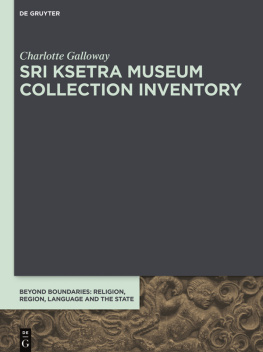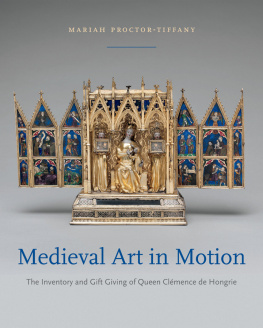Table of Contents
Guide

Charlotte Galloway
Sri Ksetra Museum Collection Inventory
Beyond Boundaries

Religion, Region, Language and the State
Edited by
Michael Willis, Sam van Schaik, Lewis Doney
Volume 7
Special editor: Jason Hawkes

Co-published with the Royal Asiatic Society of Great Britain and Ireland with support from the European Research Council Beyond Boundaries: Religion, Region, Language and the State
(Project No. 609823)


The Open Access book is available at www.degruyter.com
ISBN 978-3-11-067405-7
e-ISBN (PDF) 978-3-11-067406-4
e-ISBN (EPUB) 978-3-11-067430-9
ISSN 2510-4446
DOI https://doi.org/10.1515/9783110674064

This work is licensed under the Creative Commons Attribution-NonCommercial-NoDerivatives 4.0 International License. For details go to https://creativecommons.org/licenses/by-nc-nd/4.0/.
Library of Congress Control Number: 2022944917
Bibliographic information published by the Deutsche Nationalbibliothek
The Deutsche Nationalbibliothek lists this publication in the Deutsche
Nationalbibliografie; detailed bibliographic data are available on the internet
at http://dnb.dnb.de.
2023 the author(s), published by Walter de Gruyter GmbH, Berlin/Boston.
This book is published open access at www.degruyter.com.
Cover image: Lintel, circa 475 CE, in Srnth, Uttar Pradesh, India. Photograph by Michael Willis.
www.degruyter.com
Foreword
In Myanmar, the three Pyu cities of Halin, Beikthano and Sri Ksetra situated along the valleys of the Ayeyawaddy River constitute an important illustration of the transition from the Bronze-Iron Age of chiefdoms to the early Buddhist kingdoms of mainland Southeast Asia. The Pyu Cities are very much an indication for cultural linkage in Myanmar as well as evidence of regional exchange. They represent the Pyu Kingdoms that were prosperous for over one thousand years between B.C 200 and A.D 900.
The art and iconography of the Pyu were basically created for religious expression and presentation. Although the beginning stage of statuary creations drew on the Indian tradition, the Pyu were able to invent their own characteristics in art and iconography. The variety can be seen in early Pyu artistic craftsmanship of beads and ritual pottery. When the Hindu-Buddhist traditions were accepted the Pyu used auspicious symbols in the decorations of pottery, beads, ornaments, coins, architectural designs and even in bricks.
In June 2014, the three Pyu ancient cities were listed as world heritage sites during the 38th session of World Heritage Committee held in Doha, Qatar. The Pyu Ancient Cities is the first World Heritage site in Myanmar.
Of the three ancient cities, Sri Ksetra is the largest and most important. It is located approximately eight kilometers from Pyay Township. Inside the ancient city, the Sri Ksetra Archaeological Museum was established in 1961. This museum consistently displays around 265 cultural artefacts including large stones burial urns with Pyu inscriptions, Pyu Buddha images, Brahmanical Statues, terracotta votive tablets and figurines, Pyu silver coins, beads and other Pyu period objects.
The project for inventory of artefacts in the Sri Ksetra Museum collection has been started systematically with the assistance of Dr Charlotte Galloway, Honorary Associate Professor, College of Arts and Social Sciences, Australian National University, since 2014. In addition, we could document information about the artefacts which are on display in the Museum through the inventory project for our future generations, and our staff gained experience for compiling the inventory of artefacts in the Sri Ksetra Museum.
Finally, the Department of Archaeology and National Museum is very grateful to Dr Charlotte Galloway, who initiated the implementing of the inventory of artefacts in the Sri Ksetra Museum. I hope that visitors to the Sri Ksetra Museum enjoy the art on display and information that we share in the museum.
Kyaw Oo Lwin
Director General
Department of Archaeology and National Museum
Myanmar
Acknowledgements
The project for systematic cataloguing of the Sri Ksetra Museum collection was first suggested by archaeologist Dr Bob Hudson, while I was discussing research options for my sabbatical in 2014. My art history interests had shifted towards the early Buddhist art of Myanmar, and knowing the museum collection, the idea of being able to bring together my curatorial experience and art historical research to document the collection in collaboration with local staff took hold. Dr Thein Lwin, who was at the time Deputy Director of Archaeology, was key in supporting my proposal and it is with sincere gratitude that I thank him for his enthusiasm and practical help that enabled the project to happen.
The project started in February 2014, and much of the work was completed over two trips in the first half of the year. I returned on many further occasions for short trips which were immediately put to good use as more objects were catalogued, records reviewed and new information shared. Publication was scheduled for 2020, however, two events occurred to delay the project. First was the sudden passing of Professor Janice Stargardt early in 2020. Professor Stargardt was an expert in Pyu archaeology and had helped organise the publication of the inventory through the Asia Beyond Boundaries project. She was keen to write an introductory overview of Sri Ksetra for this catalogue. This task has been ably taken on by her then research assistant Dr Jason Hawkes who has also been involved in editing the catalogue. Her absence is keenly felt by everyone who worked with her at Sri Ksetra over many years. Second was the COVID-19 epidemic. I had hoped to return to Sri Ksetra and make a final check on some records and update some photographs, but this has not been possible. As there is ongoing uncertainty about international travel, even with some inaccuracies it is more beneficial to the broader scholarly community to publish now. I thank my research assistant, Domonkos Szabo, who has helped me check the entries during this final phase.
The project could not have been completed without the generous assistance of U Win Kyaing, Director of the FSOA Pyay, who, in addition to being so knowledgeable about the material, also facilitated staff involvement and my teaching of a museology module to students. To the staff at Sri Ksetra Museum my sincerest thanks for their genuine support, interest and willingness to cooperate and share knowledge. We spent many, many hours in often very challenging working conditions, systematically assessing and recording the objects and later, reviewing the material. Daw Myint Myint, the Museum Manager when the project started, was a stickler for accuracy and remembers everything I said. The local security and support staff at the Museum were very welcoming and it was a pleasure to see them on my return visits. I also thank U Kyaw Myo Win, Sri Ksetra site manager who has been very helpful in facilitating my more recent work with the museum staff.















